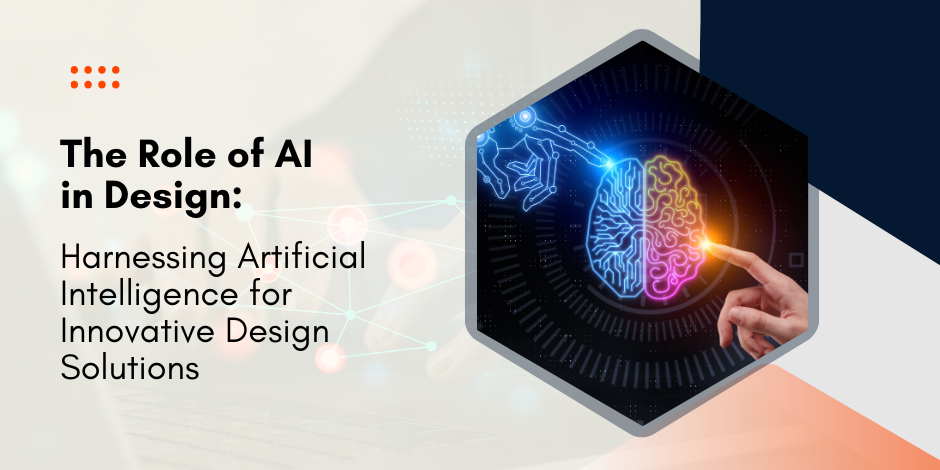The Role of AI in Design: Harnessing Artificial Intelligence for Innovative Design Solutions

Stay Informed With Our Weekly Newsletter
Receive crucial updates on the ever-evolving landscape of technology and innovation.
Artificial intelligence (AI) has rapidly emerged as a game-changing technology in various industries, and design is no exception.
As designers strive to create innovative solutions, AI offers a wealth of possibilities.
By understanding the role of AI in design and harnessing its potential, designers can unlock new levels of creativity and efficiency.
This article explores the intersection of AI and design, examines its benefits and challenges, and provides insights into the future of this dynamic field.
Understanding artificial intelligence in the context of design

In order to fully grasp the impact of AI in design, it is essential to define what AI entails and how it relates to the design process.
AI refers to the ability of machines to perform tasks that typically require human intelligence.
AI in design can analyze data, generate new ideas, and even create designs autonomously.
This technology has evolved significantly over the years and has become an integral part of the design industry.
Defining AI and its relevance to design
AI encompasses a range of techniques such as machine learning, natural language processing, and computer vision.
These capabilities enable designers to streamline their workflows, gain valuable insights from large amounts of data, and explore innovative design possibilities.
By leveraging AI tools, designers can enhance their decision-making process and deliver more impactful designs.
The evolution of AI in the design industry
The integration of AI in design has evolved rapidly in recent years.
Initially, AI was primarily used to automate repetitive tasks, such as generating design variations or creating prototypes.
However, with advancements in machine learning algorithms, AI can now learn from past designs, identify patterns, and generate unique design solutions.
This shift toward AI in design has ushered in a new era of possibilities, transforming how designers work.
The intersection of AI and design: A new era of innovation
AI in design has the potential to reshape the process, infusing it with increased efficiency, predictive capabilities, and creative insights.
This section explores how AI is changing the design process and the impact it has on design aesthetics and functionality.
How AI is changing the design process
Traditionally, the design process involved extensive research, ideation, and iterations. AI streamlines these steps by automating data analysis and generating design alternatives based on user preferences.
This allows designers to iterate more quickly and efficiently, resulting in faster design cycles and improved productivity.
The impact of AI on design aesthetics and functionality
AI tools excel in pattern recognition and can analyze large datasets to identify design trends and preferences.
By leveraging AI-generated insights, designers can create designs that resonate with their target audience.
Additionally, using AI in design can optimize designs for functionality, taking into account factors like usability, ergonomics, and sustainability.
This integration of AI in design processes allows for the creation of more visually appealing and user-friendly designs.
The benefits of integrating AI into design

The integration of AI into the design process offers numerous advantages, ranging from enhanced efficiency and productivity to fostering creativity and innovation.
Enhancing efficiency and productivity with AI
AI technologies automate time-consuming tasks, such as data analysis or generating design variations, freeing up designers to focus on more strategic and creative aspects of their work.
By offloading these routine tasks to AI, designers can work more efficiently, delivering designs at a faster pace while maintaining high-quality outputs.
AI’s role in fostering creativity and innovation in design
Contrary to the misconception that AI replaces human creativity, AI can be a powerful tool for sparking innovative ideas.
By analyzing vast amounts of design data and user feedback, AI tools can generate design alternatives or suggest improvements based on existing designs.
This collaboration between human designers and AI can enhance the creative process, inspiring new design directions and pushing the boundaries of innovation.
The challenges and considerations of using AI in design
While the potential benefits of integrating AI into design are immense, there are also several challenges and considerations that need to be addressed.
Ethical considerations when using AI in design
As AI becomes more prevalent in the design industry, ethical considerations are crucial. Designers must be mindful of potential biases embedded in AI algorithms and ensure that human values and diversity are upheld in the design process.
Additionally, protecting user privacy and maintaining transparency in AI-driven design solutions are essential to build trust and mitigate ethical concerns.
Overcoming technical challenges in AI integration
Integrating AI into existing design workflows can be a complex task. Designers need to acquire the necessary skills and knowledge to effectively utilise AI tools.
Additionally, ensuring that AI systems are seamlessly integrated into design software and platforms requires technical expertise.
Overcoming these technical challenges involves collaboration between designers, developers, and AI experts to ensure a smooth and efficient integration process.
The future of AI in design

As AI continues to advance, its impact on the design industry is likely to grow exponentially. This section looks ahead, exploring predicted trends and preparing for the AI-driven design industry.
Predicting trends in AI and design
The design industry is poised for significant transformation as AI technology continues to evolve.
The future holds promising possibilities, such as AI-generated design variations, immersive virtual reality design experiences, and even AI-powered design assistants.
These trends will reshape the way designers work and open up new avenues for creative exploration.
Preparing for an AI-driven design industry
To thrive in an AI-driven design industry, designers must embrace lifelong learning and keep abreast of the latest AI developments.
Continuously refining their skills and understanding of AI will empower designers to leverage this technology effectively and stay at the forefront of the industry.
Collaboration between designers, AI experts, and other stakeholders will be crucial in navigating the ever-evolving landscape of AI in design.
Conclusion
The role of AI in design is becoming increasingly important for designers seeking innovative solutions.
By understanding the potential of AI, designers can harness its power to streamline their workflows, enhance creativity and efficiency, and deliver more impactful designs.
While challenges and ethical considerations exist, the future holds immense possibilities for an AI-driven design industry.
Embracing AI and its capabilities will enable designers to excel in this evolving landscape and create designs that truly resonate with users.
If you want to improve your UX & UI design skills or upskill in this domain, download the Institute of Data’s UX & UI Design Program Outline.
Alternatively, we invite you to book a complimentary call with a member of our team to discuss the UX & UI Program in more detail.





